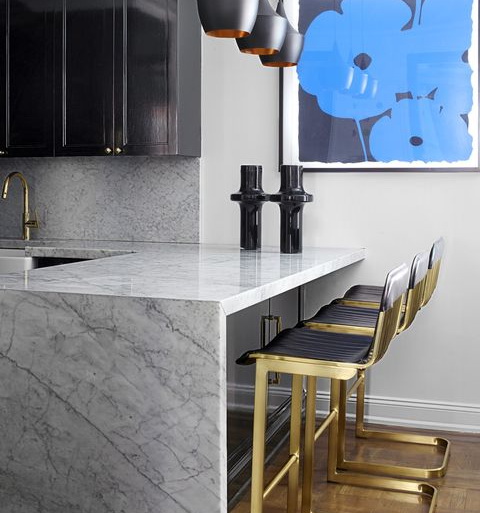Crucial Tips for Keeping Your Kitchen Benchtops for Long-lasting Appeal
Preserving the charm and durability of your kitchen benchtops needs a thoughtful strategy to care and cleansing. With numerous products and surfaces available, the ideal methods may differ-- exploring these subtleties can reveal unanticipated insights for your cooking area treatment regimen.
Regular Cleansing Practices
Keeping a pristine kitchen benchtop starts with carrying out regular cleaning techniques. This simple practice not just maintains the benchtop looking fresh however additionally decreases the threat of contamination.
In addition to day-to-day maintenance, a regular deep clean is advisable. During this procedure, consider making use of a more comprehensive remedy, such as a gentle multi-surface cleaner, to tackle any kind of stubborn spots or deposits. For products like granite or quartz, it is very important to follow supplier recommendations for cleaning products to protect their honesty.
Pay special attention to high-traffic areas where spills are most likely to take place, and don't forget to clean up the edges and corners where dust can build up. Normal cleansing not just enhances the longevity of your cooking area benchtop yet also makes certain a risk-free and inviting cooking setting. By creating these behaviors, homeowners can preserve the appeal and performance of their kitchen surfaces in time.
Staying Clear Of Harsh Chemicals
When it involves cleaning kitchen benchtops, selecting the ideal cleansing items is critical (Kitchen Benchtops). The durability and aesthetic appeal of your benchtops can be considerably compromised by the use rough chemicals. Lots of standard cleaner consist of unpleasant compounds that can scratch and boring surface areas, resulting in undesirable marks and a decrease in their total life-span
Additionally, severe chemicals can react negatively with particular materials, such as all-natural rocks or crafted surface areas, possibly causing staining or degradation. Acidic cleaners can deteriorate the finish of granite or marble, while bleach can damage artificial surfaces. It is important to decide for pH-balanced, gentle cleaning solutions that properly remove dirt and stains without taking the chance of injury to your benchtops.
Additionally, many environmentally friendly items are available on the market, which not just supply safe cleansing choices yet likewise add to a healthier cooking area atmosphere. If you choose a do it yourself technique, a mix of cozy water and moderate soap can be extremely effective (Kitchen Benchtops). By staying clear of extreme chemicals, you can preserve the beauty and stability of your cooking area benchtops for several years ahead
Utilizing Cutting Boards
Making use of cutting boards is vital for shielding your kitchen benchtops from scrapes and damages while preparing food. These boards act as an obstacle between your blades and the surface of your benchtops, substantially reducing the danger of undesirable marks and use. It is suggested to make use of a reducing board made from materials such as wood, bamboo, or plastic, as each deals unique benefits.
Wood cutting boards are recognized for their longevity and knife-friendly residential properties; they can help keep your blades sharp. Bamboo boards are an environmentally friendly choice that is light-weight and immune to knife marks. Plastic cutting boards, on the other hand, are easy to tidy and typically dishwasher risk-free, making them a useful choice for daily usage.

Securing and Shielding Surfaces
Shielding your cooking area benchtops extends beyond making use of cutting boards; sealing the surface areas plays a pivotal function in securing against discolorations, wetness, and wear. The appropriate sealer can improve the toughness of products, such as granite, quartz, and timber, ensuring they preserve their visual charm in time.

Application of the sealant should be performed in a tidy, dry environment, complying with the supplier's guidelines for ideal outcomes. Generally, this entails cleaning the surface thoroughly, using the sealant evenly, and allowing it to cure as suggested. Routine upkeep, consisting of resealing every 1-3 years depending on usage and product, will bolster protection and extend the life of your benchtops, ensuring they continue to be a magnificent centerpiece in your kitchen.
Resolving Spots Immediately
Spots on kitchen area benchtops can rapidly come to be a substantial concern otherwise addressed without delay. The longer a tarnish remains, the harder it comes to be to get rid of, potentially resulting in permanent discoloration and damages to the surface. It is vital to deal with spills and spots as quickly as they happen.
Different materials call for certain techniques to stain removal. For example, non-porous surface areas like quartz can usually be cleaned up with moderate soap and water, while porous materials, such as natural stone, might require specialized cleaners to protect against liquid penetration. Constantly refer to the maker's guidelines for the ideal cleaning methods.

Routine upkeep, including securing porous this surfaces, can dramatically minimize the read danger of staining. By immediately attending to spills and recognizing the particular needs of your benchtop product, you can maintain the aesthetic allure and performance of your kitchen surfaces for several years to come.
Verdict
To conclude, preserving the charm and performance of cooking area benchtops calls for adherence to crucial cleansing techniques, avoidance of rough chemicals, and using safety measures such as reducing boards. Normal sealing of permeable materials and prompt attention to spills and stains are important for preserving the integrity of surfaces. By carrying out these approaches, the durability and visual charm of kitchen area benchtops can be dramatically enhanced, guaranteeing a beautiful and sturdy cooking atmosphere.